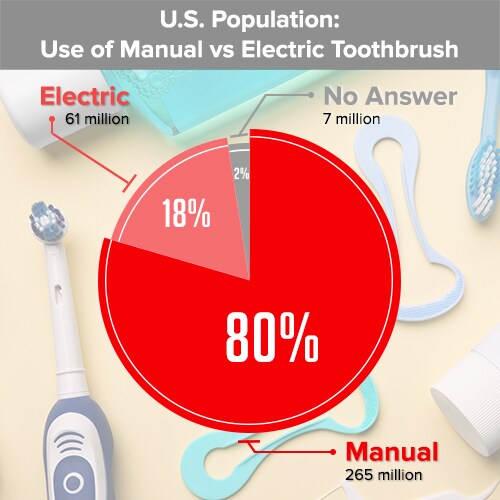Around 80% of Americans still use a manual toothbrush. By understanding and promoting best-practice use of manual toothbrushes, dental students have the opportunity to make a significant positive impact on their patients’ oral health and hygiene.
Benefits of manual toothbrushes
The American Dental Association (ADA) states that manual brushing is a safe and effective method of dental biofilm removal. Manual toothbrushes are considerably less expensive than powered toothbrushes. There also tends to be more choice in bristle style, ergonomic design, color, and other features.
It’s clear why the manual toothbrush remains such a popular choice. However, with so many options to choose from, your patients may need guidance on selecting the right manual toothbrush for their needs. Here, we’ll outline the five main characteristics to consider, and provide examples of how different patients may benefit.
Bristle configuration
The bristle configuration refers to how the bristles are positioned and trimmed to form the brushing surface, e.g., flat, angled or multi-level. The ADA cites research that found that toothbrushes with multi-level or angled bristles remove biofilm more effectively than those with flat-trimmed bristles.
For patients with standard oral health needs, a toothbrush features tapered bristles, soft rubber polishing cups and a raised cleaning tip for improved access and dental biofilm removal. It is designed for a whole mouth clean. For other patients having difficulty accessing interproximal and subgingival areas, a toothbrush features ultra soft bristles, as well as a small slim head and a flexible neck that improve access.
Patients with orthodontic appliances need a brush with bristles that can reach around wires, brackets and other fixtures.
Bristle hardness
The ADA recommends using a toothbrush with soft or ultra-soft bristles, not medium hardness bristles, to minimize the risk of gingival abrasion.
Handle ergonomics
Many manual toothbrushes now feature molded handles and/or a textured grip for comfortable, non-slip use. However, some patients may need a little extra support.
Patients with limited manual dexterity often find it difficult to grip and maneuver a standard toothbrush. This can include children, the elderly, and those with injuries or joint conditions like arthritis.
To help such patients achieve a thorough clean, you can recommend manual toothbrushes with chunky handles, cushioning, and finger supports. For children, one example is the Colgate Kids Toothbrush. And for very young children, you might recommend a training brush with additional space on the handle for an adult’s hand, allowing the parent to comfortably guide them as they brush.
Head design
Of course, oral health is about more than just the teeth and periodontium. Some manual toothbrush heads, like that of the Colgate 360 Toothbrush discussed above, also feature a soft texturized tongue and cheek cleaner on the outer aspect of the brush head.
You should also consider the shape of the brush head. For children or other patients with a crowded dentition, a standard-sized brush head may be uncomfortable to use, and it may not reach all areas of the mouth. For children and young people, the Colgate Kids Toothbrush offers a small oval head with soft material and the Colgate Fresh ‘n’ Protect Tween Toothbrush features an age-appropriate ultra-compact head for access. For adults, the small, slim head on the Colgate Slimsoft Toothbrush will help to deliver a comfortable, thorough clean.
Colors and graphics
Younger patients might need a little more encouragement when it comes to manual toothbrushing. Luckily, there are plenty of brightly colored toothbrushes designed to appeal to them. Some, like the Colgate Kids Toothbrush, feature cartoon characters to make toothbrushing a more attractive part of their day.
Time for a new manual toothbrush?
Whichever manual toothbrush your patient chooses, the Centers for Disease Control and Prevention (CDC) recommends replacing toothbrushes after 3-4 months, or sooner if the bristles are worn or splayed. Individuals often also choose to replace toothbrushes after a cold or other respiratory infection.
Consideration of all of these factors can help with making recommendations tailored for each patient.

